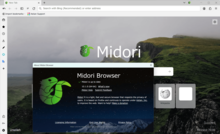Free and open-source web browser
Midori (Japanese: 緑, romanized: midori, lit. 'green') is a free and open-source web browser. In 2019, the Midori project was acquired by the Astian Foundation.[7][8] After the acquisition, the project became a derivative of the Firefox browser.[9]
History
Midori began as a lightweight[10][11] web browser using the WebKitGTK rendering engine[10] and the GTK widget toolkit. Midori was part of the Xfce desktop environment's Goodies collection of applications[12] and followed the Xfce principle of "making the most out of available resources".[13] It was the default browser in the SliTaz Linux distribution,[14] Trisquel Mini, Artix Linux, old versions of Raspbian, and wattOS in its "R5 release".[15] It was the default browser in elementary OS "Freya" and "Luna",[16] and Bodhi Linux.[17] Midori was part of the standard Raspbian distribution for the Raspberry Pi ARMv6-based computer, while Dillo and NetSurf are also in the menu. Midori is packaged with Manjaro Linux and Trisquel Mini as their default web browser as well and it even was the default web browser in elementary OS and Bodhi Linux at one time.[citation needed]
Midori passed the standard compliance Acid3 test.[18]
In March 2014, Midori scored 405/555 on the HTML5 test.[19]
In July 2015, Midori 0.5 on Windows 8 scored 325/555 on the updated HTML5 test.[20]
Reception
The former Midori was recommended by Lifehacker due to its simplicity.[29] The major points for criticism are the absence of the process isolation, the low number of available extensions[30] and occasional crashes.[citation needed]
Nick Veitch from TechRadar included Midori 0.2.2 in his 2010 list of the eight best web browsers for Linux. At that time he rated it as "5/10" and concluded, "while it does perform reasonably well all-round, there is no compelling reason to choose this browser over the default Gnome browser, Epiphany, or indeed any of the bigger boys".[31]
Himanshu Arora of Computerworld reviewed Midori 0.5.4 in November 2013 and praised the browser's speed and uncluttered interface, while additionally underlining the private browsing which uses a separate launch icon and displays the details of this mode on the home tab.[28]
Victor Clarke from Gigaom praised the former Midori's minimalism in 2014 and stated that it will "satisfy your humble needs without slowing down your PC", despite stressing the lack of advanced functionality.[32]

